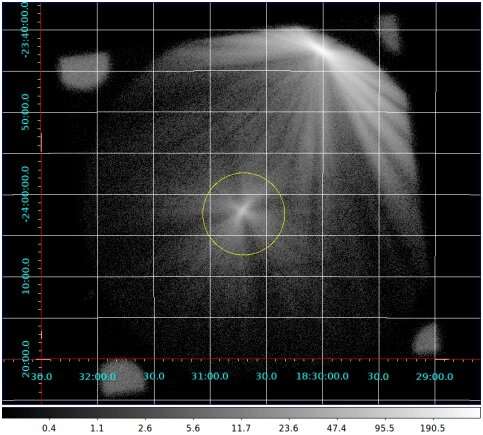Soft X-ray image of V3890 Sgr in the energy range of 0.3 to 7.0 keV taken during the second epoch of observations with the AstroSat SXT. Credit: Singh et al., 2020.
Using India's AstroSat space observatory and ESA's XMM-Newton spacecraft, astronomers have carried out X-ray observations of a symbiotic recurrent nova known as V3890 Sgr during its outburst in 2019. Results of this study, available in a paper published October 22 on arXiv.org, shed more light on the properties of this source.
Symbiotic stars (SySts) are in general long-period interacting binaries consisting of an evolved giant transferring mass to a hot compact object—usually a late-sequence red giant providing material to a white dwarf. Symbiotic novae (SyNe) are a type of SySt in which white dwarfs experience thermonuclear explosions on their surface. When these outburst occur in SyNe more than once, astronomers classify such objects as symbiotic recurrent novae (SyRNe).
SyRNe are extremely rare and to date, only four objects of this subclass have been detected. One of them is V3890 Sgr with an orbital period of 519.6 days and recurrence time of about 28 years. The system is located some 14,300 light years away from the Earth.
V3890 Sgr went into its third recorded outburst in August 2019 and shortly after the bursting activity started a team of astronomers led by Kulinder P. Singh of the Indian Institute of Science Education and Research in Mohali, India, decided to observe this SyRNe with AstroSat. In particular, they employed the spacecraft's Soft X-ray Telescope (SXT), Large Area Xenon Proportional Counters (LAXPC), and Cadmium Zinc Telluride Imager (CZTI). The study was complemented by data from the XMM-Newton satellite.
"In this paper, we present a detailed spectral analysis of X-ray emission observed with the AstroSat SXT on two extended epochs during the recent outburst of V3890 Sgr, and its spectral evolution," the researchers wrote.
AstroSat observations enhancement in the flux below 0.8 keV around the 8th day since the outburst discovery, almost coincident with the beginning of the super soft source (SSS) phase earlier on that day. In general, a stable intensity level with a hard X-ray spectrum has been observed during this phase of monitoring campaign. The astronomers attribute such behavior to shocks between the nova ejecta and the pre-existing stellar companion.
The subsequent spectral evolution of V3890 Sgr remained highly variable, which, according to the authors of the paper, demonstrates the importance of long-term high-cadence monitoring. Afterward, a complete vanishing of the supersoft emission occurred, followed by another extremely low flux state lasting for a day, starting 16 days after the outburst was detected. Meanwhile, it was also observed that the shock component was stable leading to increase in hardness ratio during the period of fading.
The astronomers underlined that their study of V3890 Sgr could have implications for our understanding of the rare population of symbiotic recurrent nova in general.
"The abruptness with which SSS emission brightens and fades (or disappears) poses a challenge to evolutionary models of the ejecta, a discussion on which is beyond the scope of this work. Long duration continuous observations with higher resolution instruments of future outbursts in such novae are needed to get a better understanding of the evolution of such systems," the researchers explained.
More information: AstroSat Soft X-ray observations of the symbiotic recurrent nova V3890 Sgr during its 2019 outburst, arXiv:2010.11455 [astro-ph.HE] arxiv.org/abs/2010.11455
© 2020 Science X Network
























